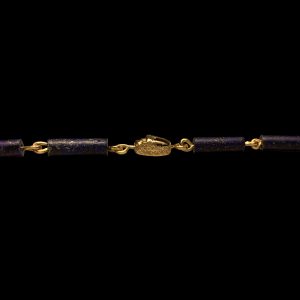The hand carved scarab bracelet below is my Goldsmiths Fair application piece.
Goldsmiths Fair is the most prestigious jewellery fair in the world. It’s held annually and organised by The Goldsmiths Company. This year will be the the year of the scarab for me!

Over the coming months I will create a scarab influenced collection entirely in 22ct gold.
To the ancient Egyptians, scarabs were the bringers of the new day, celebrated for rolling the new sun into the dawn sky. Not only does he represent the coming of the new day, he also carries a secret message that only the wearer can see. The Ma’at hieroglyph on the reverse of the scarab stands for truth and order, reminding the wearer to always be true to themselves.
Gold itself was also highly treasured, representing godliness, wealth and prestige.
Lastly, lapis lazuli was considered a royal stone, believed to contain the souls of the gods. Even the garments of priests and royalty were dyed with lapis to indicate their status. They also believed lapis lazuli would lead the soul into immortality and open the heart to love.

I really enjoyed making this scarab beetle piece. I started carving the beetle as carving for carving sake back in November. I find it very therapeutic. I wanted to emulate the rustic naivety of the carved scarabs found in tombs of Ancient Egypt.
This scarab is carved from green jewellers’ wax. I then made a silicone mould of the green wax as insurance in case anything happened to the master.
I trialled mixing different waxes to see which created the best pour into this silicone mould and found that blue injection wax and green jewellers’ wax gave the best effect.
When I achieved the desired wax, I carved patterns found in the tomb of King Tutankhamun and a hieroglyph, drilled the carving to form a bead, then sent it off for casting in 22ct gold.
Wire is hand forged from bullion, which requires a lot of hammering, heating, quenching, pickling and then more hammering to repeat the process until the wire is the desired thickness. One side of each link is soldered closed to create minimal chance of the links separating.
I used cylinder shaped lapis beads but found the holes very small, even for my now narrow gauge wire and decided to further drill out the holes using diamond burrs and water.
Before assembling completely, I brass bushed over the patterned areas of the scarab and polished the wings to a high shine to create a sense of depth. The rest of the beetle I left as a matt finish to create an aged feeling.
I made sure that most of the piece had a heavily textured low shine by giving a single polish over with white Luxi compound and a canvas mop and then thrummed in the hard to reach places with cotton and more white Luxi. Then I rinsed everything off with Ecover and warm water, using a soft toothbrush to reach into the nooks and crannies.
Believe it or not, this entire process took 2 months.
This is slow jewellery and definitely not fast fashion.

